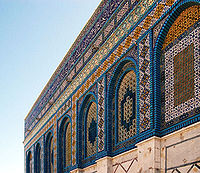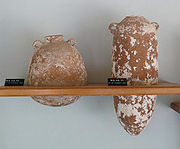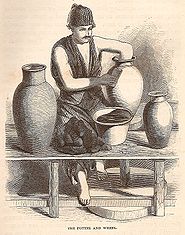
Palestinian pottery
Encyclopedia


Pottery
Pottery is the material from which the potteryware is made, of which major types include earthenware, stoneware and porcelain. The place where such wares are made is also called a pottery . Pottery also refers to the art or craft of the potter or the manufacture of pottery...
produced in Palestine
Palestine
Palestine is a conventional name, among others, used to describe the geographic region between the Mediterranean Sea and the Jordan River, and various adjoining lands....
throughout the ages, and pottery produced by modern-day Palestinians
Palestinian people
The Palestinian people, also referred to as Palestinians or Palestinian Arabs , are an Arabic-speaking people with origins in Palestine. Despite various wars and exoduses, roughly one third of the world's Palestinian population continues to reside in the area encompassing the West Bank, the Gaza...
.
Continuity through the ages
Modern Palestinian pots, bowls, jugs and cups, particularly those produced prior to the establishment of IsraelIsrael
The State of Israel is a parliamentary republic located in the Middle East, along the eastern shore of the Mediterranean Sea...
in 1948, are similar in shape, fabric and decoration to their ancient equivalents. Winifred Needler, Deputy Keeper of the Near Eastern Department at the Royal Ontario Museum
Royal Ontario Museum
The Royal Ontario Museum is a museum of world culture and natural history in Toronto, Ontario, Canada. With its main entrance facing Bloor Street in Downtown Toronto, the museum is situated north of Queen's Park and east of Philosopher's Walk in the University of Toronto...
of Archaeology writes in Palestine: Ancient and Modern (1949) that this continuity demonstrates "how persistently the potter's craft clung to tradition through the centuries." R.A. Stewart Macalister, in his work The Excavation of Gezer (1912), underlines this point prefacing his overview of Palestinian pottery throughout the ages by noting that:
"... the division into periods [of Palestinian pottery] is to some extent a necessary evil, in that it suggests a misleading idea of discontinuity - as though the periods were so many water-tight compartments with fixed partitions between them. In point of fact, each period shades almost imperceptibly into the next."
Commenting further on modern examples of Palestinian pottery, Needler notes that the clay used is of much the same composition as the ancient examples and is shaped, smoothed and baked in the same way, with the surfaces often decorated in similar painted, incised, or moulded techniques. "Ramallah
Ramallah
Ramallah is a Palestinian city in the central West Bank located 10 kilometers north of Jerusalem, adjacent to al-Bireh. It currently serves as the de facto administrative capital of the Palestinian National Authority...
" ware, a think-walled, pinkish drab pottery painted with simple geometric and plant designs in red, is handmade; as are the "frying pan" and the home-made braziers. Other pottery is wheel-made, largely undecorated, but often with a glossy black glaze and crude designs in bright red.
Roman period
During the Roman and early Byzantine period, common kitchen ware of the GalileeGalilee
Galilee , is a large region in northern Israel which overlaps with much of the administrative North District of the country. Traditionally divided into Upper Galilee , Lower Galilee , and Western Galilee , extending from Dan to the north, at the base of Mount Hermon, along Mount Lebanon to the...
region was produced primarily in Kafr 'Inan
Kafr 'Inan
Kafr ʿInān was a Palestinian village in the District of Acre around east of Acre. Until 1949, it was an Arab village situated upon ancient ruins...
(Kefar Hananya). One item produced there, the "Kefar Hananya I CE type," is also known as the "Galilean bowl." This coarse ware network was one of many sub-regional and micro-regional coarse and fine ware ceramic culture networks in operation in the Levant
Levant
The Levant or ) is the geographic region and culture zone of the "eastern Mediterranean littoral between Anatolia and Egypt" . The Levant includes most of modern Lebanon, Syria, Jordan, Israel, the Palestinian territories, and sometimes parts of Turkey and Iraq, and corresponds roughly to the...
.
Arab period
In exploring the similarities throughout the different eras, Macalister discusses Palestinian pottery in the ArabArab
Arab people, also known as Arabs , are a panethnicity primarily living in the Arab world, which is located in Western Asia and North Africa. They are identified as such on one or more of genealogical, linguistic, or cultural grounds, with tribal affiliations, and intra-tribal relationships playing...
period and its shared characteristics with the ancient and modern pottery produced in Palestine. Of the pottery from the Arab period, he notes: "...there seem to have been large globular jars, not unlike the Pre-Semitic
Semitic
In linguistics and ethnology, Semitic was first used to refer to a language family of largely Middle Eastern origin, now called the Semitic languages...
and First Semitic barrel-shaped jars." He describes them as having "ledge-handles, though of a different shape from the early ledge-handles," and continues to write that, "... this kind of handle is still made in native pottery." Further, he notes that jar-covers from this period are strikingly similar to those of the "earliest type of ware," the "Second Semitic jar-covers, with two loops in the middle of the saucer."

Byzantine
Byzantine usually refers to the Roman Empire during the Middle Ages.Byzantine may also refer to:* A citizen of the Byzantine Empire, or native Greek during the Middle Ages...
slipper form." The "Third Semitic lamp" which almost completely disappears during the Hellenistic period, comes into use once again during the Arab period and Macalister notes that it is still frequently used among the Arab inhabitants of Palestine.
Some of the linear decoration techniques also show a "startling resemblance to the painted ornament of the Second Semitic Period." Macalister notes that the major differences are that "The slip and the paint have a fatter, richer texture in the Arab ware than in the Amorite
Amorite
Amorite refers to an ancient Semitic people who occupied large parts of Mesopotamia from the 21st Century BC...
, and the painted devices are more geometrical, more mechanical, and also more minute and 'finicking' in the later than in the earlier pottery." As for similarities with the Roman period, horizontal ribbing, a key characteristic of Roman era pottery, "is as common in this period as in the Roman, but it seems to differ in outline."
Present-day Palestinian pottery
The Palestinian Association for Cultural Exchange (PACE) has put together a collection of traditional pottery, including cooking pots, jugs, mugs and plates that are manufactured by men and women from historic villages like al-Jib (Gibeon), BeitinBeitin
Beitin is a Palestinian town in the Ramallah and al-Bireh Governorate in the central West Bank, located northeast of Ramallah along the Ramallah-Nablus road...
(Bethel
Bethel
Bethel was a border city described in the Hebrew Bible as being located between Benjamin and Ephraim...
) and Senjel. They are hand-made and fired in open, charcoal-fueled kilns as in ancient times.
Palestinian ceramics are produced at traditional family-owned factories in Hebron
Hebron
Hebron , is located in the southern West Bank, south of Jerusalem. Nestled in the Judean Mountains, it lies 930 meters above sea level. It is the largest city in the West Bank and home to around 165,000 Palestinians, and over 500 Jewish settlers concentrated in and around the old quarter...
and other cities. Covering a wide range of colorful hand painted plates, vases, hanging ornaments, tiles, cups, jars and framed mirrors, the ceramics are known for the intricate detail of their flower and arabesque patterns.
Palestinian artists
Palestinian art
Palestinian art is a term used to refer to paintings, posters, installation art and other visual media produced by Palestinian artists.While the term has also been used to refer to ancient art produced in the geographical region of Palestine, in its modern usage it generally refers to work of...
who produce contemporary clay sculpture, like Vera Tamari from Ramallah
Ramallah
Ramallah is a Palestinian city in the central West Bank located 10 kilometers north of Jerusalem, adjacent to al-Bireh. It currently serves as the de facto administrative capital of the Palestinian National Authority...
, have incorporated the clay shards from ancient pieces into their work. Says Tamari,
"My own artwork is inspired by seeing the history in Palestinian land. For a time, I used a lot of shards of pottery as a theme in my clay work. You find shards of pottery everywhere because Palestine has had so many thousand of years of history that you walk on a hill and you just find these little pieces of pottery that are evidence of life that was there — pieces of jars, of plates, of bowls."
Dina Ghazal from Nablus
Nablus
Nablus is a Palestinian city in the northern West Bank, approximately north of Jerusalem, with a population of 126,132. Located in a strategic position between Mount Ebal and Mount Gerizim, it is the capital of the Nablus Governorate and a Palestinian commercial and cultural center.Founded by the...
use another approach, believing that abstraction will best express the essence of her ideas.
The qualities of the material she works with are very important for Ghazal, she explains that her work is an attempt to show the versatility of the medium and she hopes to challenge traditional perceptions of the use of the clay.
External links
- Photographs of Hebron pottery factory
- Pottery from Hebron, available in Washington D.C.
- William McClure Thomson, (1860): The Land and the Book: Or, Biblical Illustrations Drawn from the Manners and Customs, the Scenes and Scenery, of the Holy Land Vol II, p. 282.

